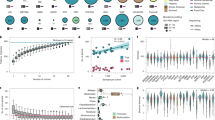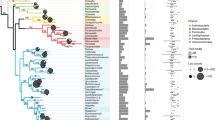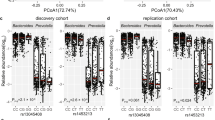Abstract
The intestinal microbiome is implicated as an important modulating factor in multiple inflammatory1,2, neurologic3 and neoplastic diseases4. Recent genome-wide association studies yielded inconsistent, underpowered and rarely replicated results such that the role of human host genetics as a contributing factor to microbiome assembly and structure remains uncertain5,6,7,8,9,10,11. Nevertheless, twin studies clearly suggest host genetics as a driver of microbiome composition11. In a genome-wide association analysis of 8,956 German individuals, we identified 38 genetic loci to be associated with single bacteria and overall microbiome composition. Further analyses confirm the identified associations of ABO histo-blood groups and FUT2 secretor status with Bacteroides and Faecalibacterium spp. Mendelian randomization analysis suggests causative and protective effects of gut microbes, with clade-specific effects on inflammatory bowel disease. This holistic investigative approach of the host, its genetics and its associated microbial communities as a ‘metaorganism’ broaden our understanding of disease etiology, and emphasize the potential for implementing microbiota in disease treatment and management.
This is a preview of subscription content, access via your institution
Access options
Access Nature and 54 other Nature Portfolio journals
Get Nature+, our best-value online-access subscription
$29.99 / 30 days
cancel any time
Subscribe to this journal
Receive 12 print issues and online access
$209.00 per year
only $17.42 per issue
Buy this article
- Purchase on Springer Link
- Instant access to full article PDF
Prices may be subject to local taxes which are calculated during checkout



Similar content being viewed by others
Data availability
Cohort-level summaries of microbial feature abundances are available in Supplementary Table 1. Complete summary statistics of all tested microbial features are available via the NHGRI-EBI GWAS catalog (https://www.ebi.ac.uk/gwas), GCP ID: GCP000068; study accession nos. GCST90011301–GCST90011730. The German mGWAS browser application is available for local query of results from Dockerhub: https://hub.docker.com/r/mruehlemann/german_mgwas_browser_app. Due to the informed consent obtained from the participants, phenotypes, as well as genotyping and not all 16S rRNA gene-sequencing data, can be deposited publicly; however, all data are available upon request from the respective biobanks (see Supplementary Note for details). PopGen and Focus: 16S rRNA-sequencing data are available at the National Center for Biotechnology Information Sequence Read Archive, accession no. PRJNA673102; http://www.uksh.de/p2n/Information+for+Researchers.html. KORA FF4: https://epi.helmholtz-muenchen.de. SHIP and SHIP-TREND: https://www.fvcm.med.uni-greifswald.de/dd_service/data_use_intro.php (German website; English-speaking assistance for the application process can be requested via: transfer@uni-greifswald.de).
Code availability
Microbiome data pre-processing, GWAS analysis and post-processing code are available via github: https://github.com/mruehlemann/german_mgwas_code.
References
Lloyd-Price, J. et al. Multi-omics of the gut microbial ecosystem in inflammatory bowel diseases. Nature 569, 655–662 (2019).
Franzosa, E. A. et al. Gut microbiome structure and metabolic activity in inflammatory bowel disease. Nat. Microbiol. 4, 293–305 (2019).
Cryan, J. F., O’Riordan, K. J., Sandhu, K., Peterson, V. & Dinan, T. G. The gut microbiome in neurological disorders. Lancet Neurol. 19, 179–194 (2019).
Wirbel, J. et al. Meta-analysis of fecal metagenomes reveals global microbial signatures that are specific for colorectal cancer. Nat. Med. 25, 679–689 (2019).
Blekhman, R. et al. Host genetic variation impacts microbiome composition across human body sites. Genome Biol. 16, 191 (2015).
Goodrich, J. K. et al. Human genetics shape the gut microbiome. Cell 159, 789–799 (2014).
Wang, J. et al. Genome-wide association analysis identifies variation in vitamin D receptor and other host factors influencing the gut microbiota. Nat. Genet. 48, 1396–1406 (2016).
Turpin, W. et al. Association of host genome with intestinal microbial composition in a large healthy cohort. Nat. Genet. 48, 1413–1417 (2016).
Bonder, M. J. et al. The effect of host genetics on the gut microbiome. Nat. Genet. 48, 1407–1412 (2016).
Rothschild, D. et al. Environment dominates over host genetics in shaping human gut microbiota. Nature 555, 210–215 (2018).
Goodrich, J. K. et al. Genetic determinants of the gut microbiome in UK twins. Cell Host Microbe 19, 731–743 (2016).
Krawczak, M. et al. PopGen: population-based recruitment of patients and controls for the analysis of complex genotype–phenotype relationships. Community Genet. 9, 55–61 (2006).
Völzke, H. [Study of Health in Pomerania (SHIP). Concept, design and selected results]. Bundesgesundheitsblatt—Gesundheitsforschung—Gesundheitsschutz 55, 790–794 (2012).
Völzke, H. et al. Cohort profile: the study of health in Pomerania. Int. J. Epidemiol. 40, 294–307 (2011).
Holle, R., Happich, M., Löwel, H. & Wichmann, H. E., MONICA/KORA Study Group. KORA—a research platform for population based health research. Gesundheitswesen Bundesverb. 67, S19–S25 (2005).
Reitmeier, S. et al. Arrhythmic gut microbiome signatures for risk profiling of type-2 diabetes. Cell Host Microbe 28, 258–272.e6 (2020).
Johnson, J. S. et al. Evaluation of 16S rRNA gene sequencing for species and strain-level microbiome analysis. Nat. Commun. 10, 5029 (2019).
Lozupone, C. & Knight, R. UniFrac: a new phylogenetic method for comparing microbial communities. Appl. Environ. Microbiol. 71, 8228–8235 (2005).
Davenport, E. R. et al. Genome-wide association studies of the human gut microbiota. PLoS ONE 10, e0140301 (2015).
Wegiel, B. et al. Biliverdin inhibits Toll-like receptor-4 (TLR4) expression through nitric oxide-dependent nuclear translocation of biliverdin reductase. Proc. Natl Acad. Sci. USA 108, 18849–18854 (2011).
Schirmer, M. et al. Linking the human gut microbiome to inflammatory cytokine production capacity. Cell 167, 1125–1136.e8 (2016).
McGovern, D. P. B. et al. Fucosyltransferase 2 (FUT2) non-secretor status is associated with Crohn’s disease. Hum. Mol. Genet. 19, 3468–3476 (2010).
Jostins, L. et al. Host-microbe interactions have shaped the genetic architecture of inflammatory bowel disease. Nature 491, 119–124 (2012).
Liu, J. Z. et al. Association analyses identify 38 susceptibility loci for inflammatory bowel disease and highlight shared genetic risk across populations. Nat. Genet. 47, 979–986 (2015).
de Lange, K. M. et al. Genome-wide association study implicates immune activation of multiple integrin genes in inflammatory bowel disease. Nat. Genet. 49, 256–261 (2017).
Smith, G. D. & Ebrahim, S. Mendelian Randomization: Genetic Variants as Instruments for Strengthening Causal Inference in Observational Studies (National Academies Press, 2008).
Wade, K. H. & Hall, L. J. Improving causality in microbiome research: can human genetic epidemiology help? Wellcome Open Res. 4, 199 (2020).
Hemani, G. et al. The MR-Base platform supports systematic causal inference across the human phenome. eLife 7, e34408 (2018).
Arumugam, M. et al. Enterotypes of the human gut microbiome. Nature 473, 174–180 (2011).
Wu, G. D. et al. Linking long-term dietary patterns with gut microbial enterotypes. Science 334, 105–108 (2011).
Costea, P. I. et al. Enterotypes in the landscape of gut microbial community composition. Nat. Microbiol. 3, 8–16 (2018).
Vieira-Silva, S. et al. Quantitative microbiome profiling disentangles inflammation- and bile duct obstruction-associated microbiota alterations across PSC/IBD diagnoses. Nat. Microbiol. 4, 1826–1831 (2019).
Zhou, Y. & Zhi, F. Lower level of bacteroides in the gut microbiota is associated with inflammatory bowel disease: a meta-analysis. BioMed. Res. Int. 2016, 5828959 (2016).
Wang, K. et al. Parabacteroides distasonis alleviates obesity and metabolic dysfunctions via production of succinate and secondary bile acids. Cell Rep. 26, 222–235.e5 (2019).
Watanabe, K., Taskesen, E., van. Bochoven, A. & Posthuma, D. Functional mapping and annotation of genetic associations with FUMA. Nat. Commun. 8, 1826 (2017).
Davenport, E. R. et al. ABO antigen and secretor statuses are not associated with gut microbiota composition in 1,500 twins. BMC Genomics 17, 941 (2016).
Turpin, W. et al. FUT2 genotype and secretory status are not associated with fecal microbial composition and inferred function in healthy subjects. Gut Microbes 9, 357–368 (2018).
Rausch, P. et al. Colonic mucosa-associated microbiota is influenced by an interaction of Crohn disease and FUT2 (secretor) genotype. Proc. Natl Acad. Sci. USA 108, 19030–19035 (2011).
Weiss, F. U. et al. Fucosyltransferase 2 (FUT2) non-secretor status and blood group B are associated with elevated serum lipase activity in asymptomatic subjects, and an increased risk for chronic pancreatitis: a genetic association study. Gut 64, 646–656 (2015).
Godon, J. J., Zumstein, E., Dabert, P., Habouzit, F. & Moletta, R. Molecular microbial diversity of an anaerobic digestor as determined by small-subunit rDNA sequence analysis. Appl. Environ. Microbiol. 63, 2802–2813 (1997).
Frost, F. et al. Impaired exocrine pancreatic function associates with changes in intestinal microbiota composition and diversity. Gastroenterology 156, 1010–1015 (2019).
Paré, G. et al. Novel association of ABO histo-blood group antigen with soluble ICAM-1: results of a genome-wide association study of 6,578 women. PLoS Genet. 4, e1000118 (2008).
R Core Team. R: A Language and Environment for Statistical Computing (R Foundation for Statistical Computing, 2014).
Callahan, B. J. et al. DADA2: high-resolution sample inference from Illumina amplicon data. Nat. Methods 13, 581–583 (2016).
Cole, J. R. et al. Ribosomal database project: data and tools for high throughput rRNA analysis. Nucleic Acids Res. 42, D633–D642 (2014).
McMurdie, P. J. & Holmes, S. phyloseq: An R package for reproducible interactive analysis and graphics of microbiome census data. PLoS ONE 8, e61217 (2013).
Edgar, R. C. Updating the 97% identity threshold for 16S ribosomal RNA OTUs. Bioinformatics 34, 2371–2375 (2018).
Rognes, T., Flouri, T., Nichols, B., Quince, C. & Mahé, F. VSEARCH: a versatile open source tool for metagenomics. Peer J. 4, e2584 (2016).
Quast, C. et al. The SILVA ribosomal RNA gene database project: improved data processing and web-based tools. Nucleic Acids Res. 41, D590–D596 (2013).
Price, M. N., Dehal, P. S. & Arkin, A. P. FastTree 2—approximately maximum-likelihood trees for large alignments. PLoS ONE 5, e9490 (2010).
Oksanen, J. et al. The vegan package. Community Ecol. Package 10, 631–637 (2007).
Zhou, J. & Ning, D. Stochastic community assembly: does it matter in microbial ecology? Microbiol. Mol. Biol. Rev. 81, e00002–e00017 (2017).
Rühlemann, M. C. et al. Application of the distance-based F test in an mGWAS investigating β diversity of intestinal microbiota identifies variants in SLC9A8 (NHE8) and 3 other loci. Gut Microbes 9, 68–75 (2017).
Willer, C. J., Li, Y. & Abecasis, G. R. METAL: fast and efficient meta-analysis of genomewide association scans. Bioinformatics 26, 2190–2191 (2010).
Qin, Y. et al. Combined effects of host genetics and diet on human gut microbiota and incident disease in a single population cohort. Preprint at medRxiv https://doi.org/10.1101/2020.09.12.20193045 (2020).
Li, J. & Ji, L. Adjusting multiple testing in multilocus analyses using the eigenvalues of a correlation matrix. Heredity 95, 221–227 (2005).
Deeks, J. J., Higgins, J. P. & Altman, D. G. in Cochrane Handbook for Systematic Reviews of Interventions (eds. Higgins, J. P. T. & Green, S.) 243–296 (John Wiley & Sons, 2008).
Yarmolinsky, J. et al. Circulating selenium and prostate cancer risk: a Mendelian randomization analysis. J. Natl Cancer Inst. 110, 1035–1038 (2018).
Acknowledgements
We thank T. Hauptmann, I. Urbach and I. Wulf of the IKMB Microbiome Lab for excellent technical assistance. We thank K. Wade for her valuable input on the MR analysis and M. Schulzky for support in figure design. This work was supported by the Deutsche Forschungsgemeinschaft (DFG) Collaborative Research Center 1182 ‘Origin and Function of Metaorganisms’ (grant no. SFB1182, Project A2 to A.F.) and the DFG Cluster of Excellence 2167 ‘Precision Medicine in Chronic Inflammation (PMI)’ (grant no. EXC2167 to A.F.). The SHIP part of the study was supported by the PePPP-project (ESF/14-BM-A55_0045/16 to M.M.L.) and the RESPONSE-project (BMBF grant no. 03ZZ0921E to M.M.L.). The SHIP is part of the Research Network Community Medicine of the University Medicine Greifswald, which is supported by the German Federal State of Mecklenburg-West Pomerania.
Author information
Authors and Affiliations
Contributions
M.C.R. performed microbiome sample preparation, data generation and curation, implemented ABO blood group inference, implemented statistical models, performed the (meta-)analysis, curated and interpreted results, and wrote the manuscript draft. B.M.H. curated and interpreted results and wrote the manuscript draft. C.B. performed microbiome sample preparation, data generation, curated and interpreted results, and advised in the writing of the draft manuscript. S.D. implemented statistical models, performed the (meta-)analysis and wrote the manuscript draft. L.M.-S. and L.B.T. curated and interpreted results. F.F. and F.D. performed data QC and curation. M.W. implemented ABO blood group inference. J.K. implemented statistical models and performed the (meta-)analysis. F.U.W. performed microbiome sample preparation, data generation and curation. A.P., U.V., S.W. H.G., M.L. and W.L. performed genotype and phenotype data generation and collection. K.H. performed microbiome sample preparation, data generation and curation. H.V. performed genotype and phenotype data generation and collection and data QC and curation. G.H. performed genotype and phenotype data collection. D.H. and M.M.L. designed the experiment. J.F.B. and A.F. designed the experiment and advised on the writing of the draft manuscript. All authors reviewed, edited and approved the final manuscript.
Corresponding author
Ethics declarations
Competing interests
The authors declare no competing interests.
Additional information
Peer review information Nature Genetics thanks Tao Zhang, Jonathan Braun and the other, anonymous, reviewer(s) for their contribution to the peer review of this work.
Publisher’s note Springer Nature remains neutral with regard to jurisdictional claims in published maps and institutional affiliations.
Supplementary information
Supplementary information
Supplementary Notes 1–6 and Supplementary Figs. 1–3.
Supplementary Tables
Supplementary Tables 1–8.
Rights and permissions
About this article
Cite this article
Rühlemann, M.C., Hermes, B.M., Bang, C. et al. Genome-wide association study in 8,956 German individuals identifies influence of ABO histo-blood groups on gut microbiome. Nat Genet 53, 147–155 (2021). https://doi.org/10.1038/s41588-020-00747-1
Received:
Accepted:
Published:
Issue Date:
DOI: https://doi.org/10.1038/s41588-020-00747-1
This article is cited by
-
Human genetic associations of the airway microbiome in chronic obstructive pulmonary disease
Respiratory Research (2024)
-
Using rare genetic mutations to revisit structural brain asymmetry
Nature Communications (2024)
-
Host genetic regulation of human gut microbial structural variation
Nature (2024)
-
Using the collaborative cross to identify the role of host genetics in defining the murine gut microbiome
Microbiome (2023)
-
Impact of the gut microbiota and associated metabolites on cardiometabolic traits, chronic diseases and human longevity: a Mendelian randomization study
Journal of Translational Medicine (2023)



